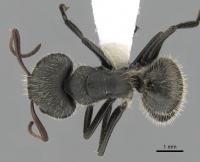Myrmobrachys
| Myrmobrachys | |
|---|---|

| |
| Scientific classification | |
| Kingdom: | Animalia |
| Phylum: | Arthropoda |
| Class: | Insecta |
| Order: | Hymenoptera |
| Family: | Formicidae |
| Subfamily: | Formicinae |
| Tribe: | Camponotini |
| Genus: | Camponotus |
| Subgenus: | Myrmobrachys Forel, 1912 |
| Type species | |
| Formica senex, now Camponotus senex
| |
Blocky Carpenter Ants
Diagnosis: Emery (1925). - "Worker and soldier. - In general small species; dimorphism highly variable; when major difference in head sculpture exists between extreme forms of worker (i.e., between majors and minors, such that majors distinct), little to no transition between castes observed (C. striatus, F. Smith, dimorphus, Emery). Head short: in majors (= soldier), head usually square to trapezoidal in form, somewhat narrowed anteriorly, and with lateral margins somewhat convex; in minors, head markedly narrower anteriorly, with posterior head margin more-or-less straight, and eyes set close to posterior margin (their distance from posterior margin generally less than longitudinal diameter of eye); eyes more prominent among larger workers. Clypeus very convex, if not flat, carinate or ecarinate, broad, with anterior margin convex in minors, relatively narrow, with anterior margin linear or with very short, truncated lobe in majors and soldiers. Frontal carinae strongly divergent posteriorly, sinuate; antennal insertions situated well before midlength of frontal carinae. Mesosoma short; dorsum continuous, arched, or interrupted by notch anterior to propodeum; in latter case, metanotal spiracles visible in dorsal view; pronotum rarely bordered, more often pronotum submarginate or even rounded; mesonotum and propodeum rarely bordered; dorsal and posterior faces of propodeum usually forming curved surface or rounded angle. Petiole squamiform, thin or thick, rarely nodiform. Queen. - Head and clypeus same as in majors or soldiers. Mesosoma somewhat elongate, dorsum depressed: mesoscutum, mesoscutellum, and propodeum at about same level. Male. - More-or-less similar to Colobopsis.
Geographical distribution of the species. Same as that of Myrmaphaenus.
Ethology. - Goeldi observed that C. senex var. textor, Forel, builds nests in leaves using silk secreted by the larvae that the workers hold between their mandibles, just as in Oecophylla. It is likely that other species are practicing the same industry; however, other species inhabit dry branches, spines, etc. (C. planatus var. aacaciae, Emery, C. striatus, F. Smith). This subgenus, as well as the following four (Myrmocladoecus, Myrmeurynota, Myrmodirachis, and Myrmomalis) represent a natural group, distributed throughout the Neotropics, which is characterized chiefly by the head of minors, which, with few exceptions, is wide, posteriorly straight, and with the eyes placed near the posterolateral angles. This group corresponds exactly to the last manipolo of my 1896 classification."
(Translated and edited by B. E. Boudinot, 19 February 2017.)
Myrmobrachys is currently a subgenus of Camponotus.
Species groups of Myrmobrachys
Emery (1925) established three informal species groups within Myrmobrachys, which he defined as follows:
"Group I: senex
Diagnosis. - Worker - Mesosomal dorsum continuous; head of major not or very obtusely subtruncate anteriorly, without major difference in sculpture of minors.
Group II: dimorphus
Diagnosis. - Worker and soldier - Mesosomal dorsum generally interrupted by notch anterior to propodeum (rarely continuous); head of major worker (soldier) more-or-less obtusely truncate anteriorly; most often considerable difference in sculpture exists between major and minor worker head sculpture (Myrmamblys [part], sensu Forel).
Group III: burtoni
Diagnosis. - According to the description, this species can not fit into any of the two preceding groups, because of the fusion of the posterior segments of the mesosoma in majors (soldiers)."
Nomenclature
The following information is derived from Barry Bolton's Online Catalogue of the Ants of the World.
- MYRMOBRACHYS [subgenus of Camponotus]
- Myrmobrachys Forel, 1912i: 91 [as subgenus of Camponotus]. Type-species: Formica senex, by subsequent designation of Wheeler, W.M. 1913a: 81.
References
- Bolton, B. 2003. Synopsis and Classification of Formicidae. Mem. Am. Entomol. Inst. 71: 370pp (page 115, Myrmobrachys as subgenus of Camponotus)
- Emery, C. 1920b. Le genre Camponotus Mayr. Nouvel essai de la subdivision en sous-genres. Rev. Zool. Afr. (Bruss.) 8: 229-260 (page 251, Myrmobrachys as subgenus of Camponotus)
- Forel, A. 1912j. Formicides néotropiques. Part VI. 5me sous-famille Camponotinae Forel. Mém. Soc. Entomol. Belg. 20: 59-92 (page 91, Myrmobrachys as subgenus of Camponotus)
- Forel, A. 1914a. Le genre Camponotus Mayr et les genres voisins. Rev. Suisse Zool. 22: 257-276 (page 262, Myrmobrachys as subgenus of Camponotus)
- Forel, A. 1917. Cadre synoptique actuel de la faune universelle des fourmis. Bull. Soc. Vaudoise Sci. Nat. 51: 229-253 (page 251, Myrmobrachys as subgenus of Camponotus)
- Wheeler, W. M. 1913a. Corrections and additions to "List of type species of the genera and subgenera of Formicidae". Ann. N. Y. Acad. Sci. 23: 77-83 (page 81, Type-species: Formica senex, by subsequent designation)
- Wheeler, W. M. 1922i. Ants of the American Museum Congo expedition. A contribution to the myrmecology of Africa. VII. Keys to the genera and subgenera of ants. Bull. Am. Mus. Nat. Hist. 45: 631-710 (page 709, Myrmobrachys as subgenus of Camponotus)

